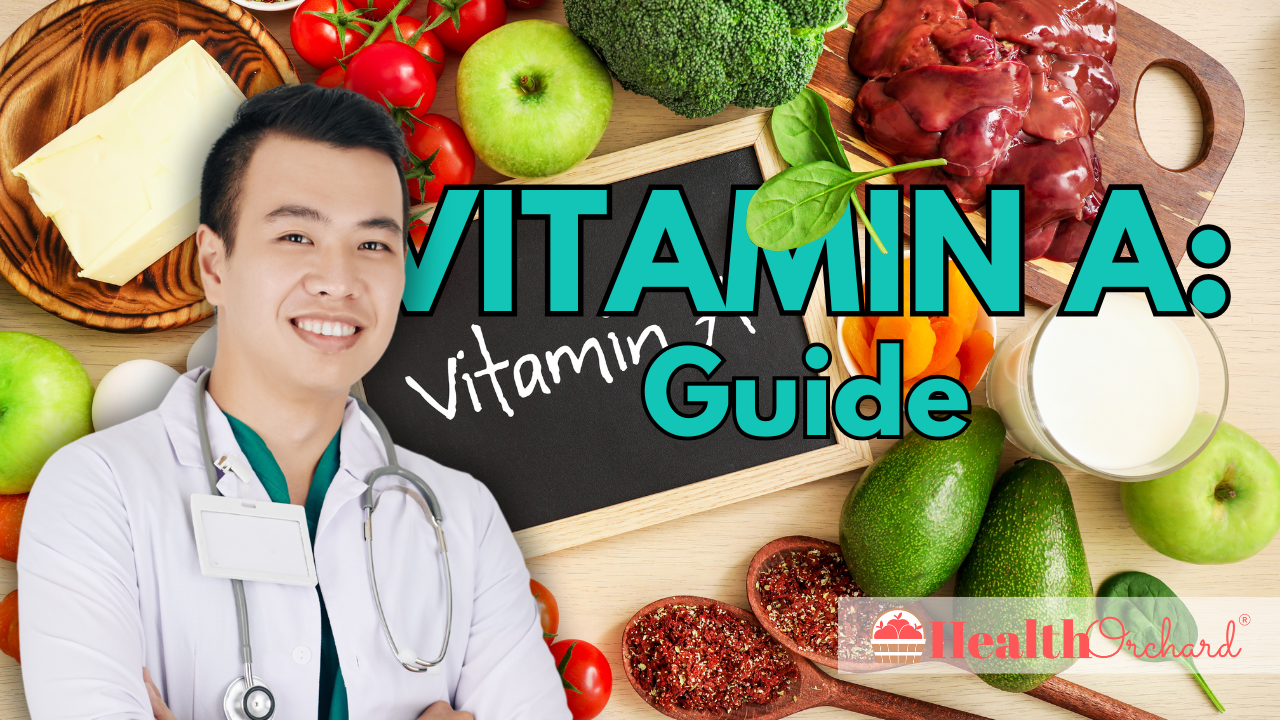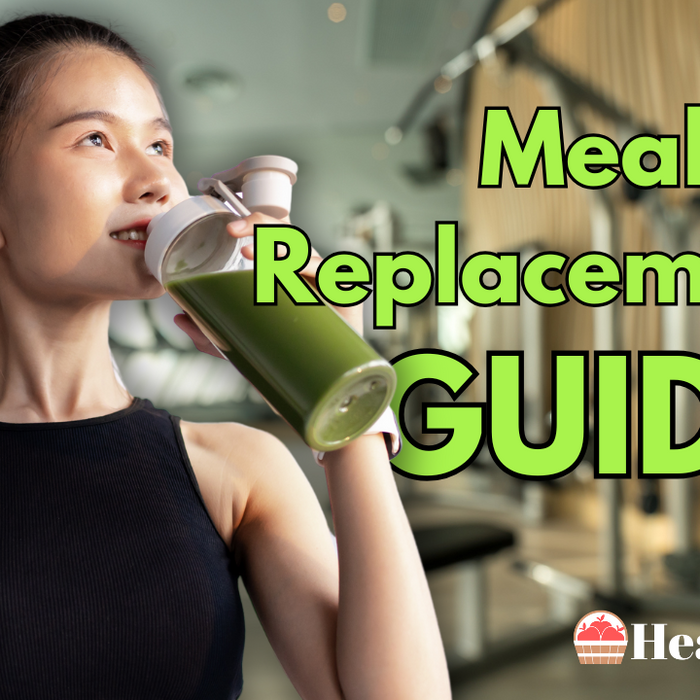

Vitamin A: Guide
Key Takeaways
- Vitamin A is Essential for Health: It supports vision, immune function, reproduction, and skin health.
- Deficiency Can Lead to Serious Issues: Low levels can cause night blindness, dry eyes, weakened immunity, and stunted growth.
- Both Animal and Plant Foods Provide Vitamin A: Retinol comes from animal products, while beta-carotene is found in colourful vegetables.
- Overconsumption Can Cause Toxicity: Excessive intake, especially through supplements, may result in liver damage, bone loss, and headaches.
- Beta-carotene is Safer than Retinol: The body only converts beta-carotene as needed, but too much can cause carotenemia.
- Monitor Intake for Balance: A mix of whole foods and cautious supplementation ensures you meet your needs without risk of toxicity.
Vitamin A plays an essential role in keeping your body healthy, from maintaining good vision to boosting immunity. This fat-soluble vitamin is available in two primary forms: retinol, which comes from animal-based foods, and beta-carotene, found in plant sources. Retinol is the active form the body uses directly, while beta-carotene is converted to retinol in the small intestine. An adequate intake of vitamin A can prevent common health issues like night blindness, but both deficiency and overconsumption pose risks.
At Health Orchard, we believe that understanding essential nutrients like vitamin A is key to maintaining a healthy lifestyle. Whether you’re looking to support your immune system, improve your diet, or maintain eye health, getting the right amount of vitamin A through food or supplements is essential. Supplements may be helpful in certain cases, especially for individuals with specific dietary needs or absorption issues. Knowing how to balance vitamin A intake can make a significant difference in your health and well-being.
What is Vitamin A?
Vitamin A is a fat-soluble nutrient that is essential for many bodily functions, such as maintaining vision, immune response, reproduction, and cellular health. The two key forms of vitamin A are retinol (and its ester form, retinyl ester) and beta-carotene. Retinol is found in animal-based foods, while beta-carotene, a carotenoid pigment, is found in colourful plant-based foods. These forms are absorbed and used differently in the body, with beta-carotene requiring conversion to retinol before it can be utilized.
The fact that the body only converts beta-carotene to retinol as needed helps prevent toxicity from plant-based sources. In contrast, retinol from animal sources can accumulate in the body if consumed in excess, increasing the risk of toxicity. Since vitamin A is stored in the liver, it’s slowly released into the bloodstream to meet the body’s needs. This storage ability makes it essential to maintain proper intake over time without relying too heavily on supplements.
Health Benefits of Vitamin A
Eye Health
Vitamin A plays a crucial role in preserving eye health and ensuring proper vision. It forms rhodopsin, a light-sensitive pigment found in the retina that helps the eye adapt to low-light conditions. When vitamin A levels are low, rhodopsin production declines, leading to night blindness—a condition that makes it difficult to see in dim light. In more severe cases, prolonged deficiency can result in xerophthalmia, a serious condition that causes dryness of the eyes and corneal damage.
Additionally, vitamin A may help reduce the risk of age-related macular degeneration (AMD), a leading cause of vision loss among older adults. Studies suggest that adequate intake of vitamin A, along with other antioxidants, can slow the progression of AMD. Ensuring a diet rich in vitamin A—particularly from sources like carrots, sweet potatoes, and fish—supports long-term eye health and helps prevent vision-related disorders.
Immune System Support
Vitamin A is essential for maintaining a strong and responsive immune system. It supports the production and function of white blood cells, which help the body fight infections. Vitamin A also maintains the health of epithelial tissues—the protective layers that line the respiratory, gastrointestinal, and urinary tracts. These tissues act as a barrier, preventing harmful bacteria and viruses from entering the body.
Studies have shown that individuals with low vitamin A levels are more susceptible to infections, particularly respiratory illnesses and diarrheal diseases. This makes the nutrient especially important for populations at risk, such as young children and pregnant women. In some cases, vitamin A supplements are administered to boost immunity and reduce child mortality in regions where deficiency is common. Maintaining adequate levels through diet and, when necessary, supplementation helps keep the immune system functioning properly.
Skin and Cellular Health
Vitamin A promotes cell growth and regeneration, making it a critical component in maintaining healthy skin. It supports the production of new skin cells while regulating sebum production, which helps prevent clogged pores and reduces the occurrence of acne. Many over-the-counter and prescription skincare products contain retinoids, which are derived from vitamin A, to treat conditions like acne, fine lines, and hyperpigmentation.
Beyond cosmetic benefits, vitamin A plays a role in wound healing by promoting collagen production and reducing inflammation. Skin conditions such as eczema and psoriasis may also improve with adequate vitamin A intake. Incorporating vitamin A-rich foods or using topical retinoids as part of a skincare routine helps maintain skin health and reduces the signs of aging.
Reproductive Health
Vitamin A plays an essential role in reproductive function for both men and women. In men, vitamin A is involved in sperm production and overall reproductive health. For women, it supports embryonic development, ensuring proper formation of organs and tissues during pregnancy. Insufficient vitamin A levels during pregnancy can lead to complications, including preterm birth or impaired fetal growth.
Pregnant and lactating women need higher levels of vitamin A to meet the increased nutritional demands of the body. However, it’s crucial to avoid excessive intake during pregnancy, as too much retinol can cause birth defects. For this reason, pregnant women are often advised to focus on dietary sources rather than supplements, unless recommended by a healthcare provider. Balancing vitamin A intake is essential for reproductive health and healthy pregnancy outcomes.

Sources of Vitamin A
Animal-based Sources (Retinol)
Animal-based foods provide retinol, the most active form of vitamin A. Liver—especially beef and chicken liver—is the richest source, containing far more vitamin A than other foods. Cod liver oil is another concentrated source, often used in supplements. Eggs, milk, cheese, and yogurt also contain smaller but significant amounts of retinol, making them a valuable part of a balanced diet.
Because retinol is easily absorbed and stored in the liver, it’s important to consume these foods in moderation to avoid toxicity. Incorporating these foods into your diet several times a week can help meet your vitamin A needs, particularly for individuals with higher requirements, such as children and pregnant women.
Plant-based Sources (Beta-carotene)
Beta-carotene, the plant-based precursor of retinol, is found in orange and dark green vegetables. Carrots, sweet potatoes, pumpkin, and apricots are rich in beta-carotene, as are leafy greens like spinach and kale. Since beta-carotene is water-soluble and less likely to cause toxicity, it’s considered a safer option for increasing vitamin A intake through food.
The absorption of beta-carotene is enhanced by dietary fats, so pairing these vegetables with healthy oils or nuts improves bioavailability. Plant-based sources are an excellent choice for vegans and vegetarians, offering a way to maintain adequate vitamin A levels without animal products.
Fortified Foods
In many countries, certain foods are fortified with vitamin A to help individuals meet their nutritional needs. Products like breakfast cereals, plant-based milk alternatives, and margarine often contain added vitamin A. These fortified foods are especially beneficial for individuals with restricted diets, such as vegans or those with dairy intolerances.
Fortified foods provide a convenient way to ensure adequate intake, particularly for people who struggle to consume enough vitamin A-rich foods. However, it's essential to monitor total intake from both natural and fortified sources to avoid exceeding recommended limits.
Recommended Daily Intake
The amount of vitamin A required depends on age, gender, and life stage. Health authorities in various regions provide guidelines for daily intake. Generally, recommendations include 900 mcg for adult men, 700 mcg for adult women, 770 mcg during pregnancy, and 1,300 mcg while breastfeeding. These amounts reflect the minimum intake needed to maintain healthy bodily functions.
To prevent toxicity, the upper intake limit for adults is often set at 3,000 mcg per day. Excessive consumption from supplements or foods like liver can lead to health issues over time. It's important to track intake from all sources, especially if you use multivitamins or eat a diet rich in fortified products.
This expanded article ensures you have all the information needed to maintain proper vitamin A intake for optimal health.
Vitamin A Deficiency
Symptoms of Deficiency
Vitamin A deficiency can lead to several health issues, particularly affecting vision and immune function. One of the earliest signs is night blindness, where individuals struggle to see in dim light or darkness due to reduced rhodopsin levels in the retina. If left untreated, this deficiency can progress to xerophthalmia, a condition characterized by dryness and thickening of the conjunctiva and cornea, potentially leading to permanent blindness. Additionally, individuals with low vitamin A levels may experience dry or irritated skin, as the vitamin is essential for maintaining healthy epithelial tissues.
A weakened immune system is another consequence of vitamin A deficiency, making individuals more prone to infections, particularly respiratory illnesses and diarrhea. Children suffering from chronic deficiency are especially vulnerable, experiencing delayed growth, stunted bone development, and higher mortality rates from infections like measles. The deficiency can also impair wound healing and lead to fatigue, as the body's tissues struggle to regenerate effectively without adequate vitamin A.
Populations at Risk
Certain groups are more susceptible to vitamin A deficiency due to higher nutritional needs or reduced ability to absorb the nutrient. Pregnant and breastfeeding women are at greater risk since they require more vitamin A to support fetal development and milk production. In developing countries, vitamin A deficiency is a major public health concern, contributing to infant mortality and birth defects. Infants who are not breastfed or have poor diets may also experience deficiency-related complications.
Vegans and individuals following plant-based diets face challenges in meeting their vitamin A requirements, as they rely solely on beta-carotene from plants, which is less efficiently converted to active retinol. People with malabsorption disorders like Crohn’s disease, celiac disease, or cystic fibrosis also struggle to absorb fat-soluble vitamins, increasing their risk of deficiency. Addressing these issues typically involves dietary adjustments and, in some cases, vitamin A supplements. Health Orchard offers trusted vitamin A products designed to help meet nutritional needs safely and effectively.
Vitamin A Toxicity (Hypervitaminosis A)
Symptoms of Toxicity
While vitamin A is crucial for health, consuming excessive amounts—particularly through supplements or certain animal products—can result in hypervitaminosis A, or vitamin A toxicity. Early signs include headaches, nausea, and dizziness, which often resemble symptoms of other conditions, making it difficult to diagnose. Some individuals may experience blurred vision or muscle pain, while others develop skin irritation or peeling due to the body’s inability to regulate the excess vitamin.
Long-term toxicity can lead to more severe health problems, including fatigue, liver damage, and mental health symptoms such as irritability or confusion. The liver, where vitamin A is stored, becomes overburdened, leading to possible hepatotoxicity (liver injury) if intake isn’t reduced. Other complications of chronic toxicity include osteoporosis and fractures, as excessive vitamin A interferes with bone metabolism. It's crucial to monitor consumption and avoid high-dose supplements without medical supervision.
Acute vs. Chronic Toxicity
Vitamin A toxicity can be acute or chronic, depending on the amount consumed and the duration of exposure. Acute toxicity occurs when a large dose is ingested in a short time, such as through an overdose of supplements or the consumption of large amounts of animal liver. Symptoms typically appear within a few hours and may include vomiting, dizziness, and severe headaches. Acute toxicity is rare but can be dangerous, especially in children.
Chronic toxicity develops more gradually, often as a result of consistent overuse of supplements or regular consumption of high-retinol foods. Unlike acute toxicity, chronic symptoms may be subtle at first, leading to long-term liver damage or bone loss before being detected. For this reason, it is essential to monitor vitamin A intake from all sources and consult a healthcare provider before starting high-dose supplementation.
Risks of High Beta-carotene Intake
Beta-carotene, the plant-based precursor of vitamin A, is generally safer than retinol because the body only converts it as needed. However, consuming excessive beta-carotene—either through supplements or large amounts of certain vegetables—can cause carotenemia, a harmless condition where the skin takes on a yellow or orange hue. Although it is not dangerous, carotenemia can cause cosmetic concerns and may signal overconsumption.
High beta-carotene intake may pose a greater risk for smokers or individuals exposed to asbestos, as some studies have suggested an increased risk of lung cancer in these groups when taking beta-carotene supplements. To avoid unnecessary health risks, it is best to obtain beta-carotene from whole foods rather than supplements unless advised otherwise by a healthcare provider.
How to Balance Vitamin A Intake
Tips for Maintaining Healthy Vitamin A Levels
Maintaining healthy vitamin A levels requires a balanced diet that includes both animal-based and plant-based sources. Foods such as liver, eggs, dairy, and oily fish provide active retinol, while carrots, sweet potatoes, spinach, and other colourful vegetables are excellent sources of beta-carotene. Pairing beta-carotene-rich foods with healthy fats—like olive oil or avocados—can improve absorption. A well-rounded diet that incorporates these foods several times a week can help meet daily vitamin A requirements.
Supplements can be beneficial for individuals with specific dietary needs or medical conditions but should be used with caution. Pregnant women, vegans, and those with malabsorption disorders may require additional vitamin A, but it’s essential to consult with a healthcare provider before starting supplementation. Over-reliance on supplements can increase the risk of toxicity, especially if combined with a diet rich in fortified foods. Health Orchard provides trusted supplements that make it easy to compare products and find the best options for your health.
Monitoring Intake to Prevent Overconsumption
It’s important to monitor vitamin A intake from fortified foods, multivitamins, and individual supplements to avoid accidental overconsumption. Many common products, such as breakfast cereals and plant-based milk alternatives, contain added vitamin A. Reading product labels and tracking your daily intake helps ensure you stay within the recommended limits of 900 mcg for men and 700 mcg for women. The upper limit of 3,000 mcg per day should not be exceeded to prevent toxicity.
Individuals taking multivitamins should be mindful of how much retinol or beta-carotene they receive from other dietary sources. When supplements are necessary, choosing lower-dose or balanced formulas can help reduce the risk of overconsumption. Health Orchard offers a variety of supplements tailored to different needs, allowing you to select products that fit your lifestyle while ensuring safe, effective vitamin A intake.
Conclusion
Vitamin A is a vital nutrient that supports your vision, immune system, and skin health. Both deficiency and overconsumption can have significant health consequences, so maintaining a balanced intake is essential. While whole foods are the best source of vitamin A, supplements can be helpful for individuals with specific dietary needs.
If you need help filling nutritional gaps, Health Orchard offers a variety of vitamin A supplements from trusted sellers like Walmart, iHerb, and Amazon. Compare prices, read reviews, and choose the best products for your health goals.
Take control of your health with the right nutrition today. Visit Health Orchard to explore our collection of vitamins and supplements and find the perfect solution to support your lifestyle.
Frequently Asked Questions about Vitamin A
1. What are vitamin A supplements good for?
Vitamin A supplements support eye health, immune function, and skin maintenance. They're beneficial for individuals with deficiencies or specific health conditions. However, most people can obtain adequate vitamin A from a balanced diet without supplementation.
2. Is it safe to take vitamin A daily?
Daily vitamin A intake is safe within recommended limits. However, excessive consumption can lead to toxicity. It's crucial to consult a healthcare provider before starting any supplement regimen, especially for pregnant women or those with pre-existing conditions.
3. How much vitamin A should I take?
The recommended dietary allowance (RDA) for vitamin A is 900 mcg for adult men and 700 mcg for adult women. Pregnant women need 770 mcg, while lactating women require 1,300 mcg. These amounts can typically be obtained through a balanced diet.
4. Which food is rich in vitamin A?
Foods rich in vitamin A include sweet potatoes, carrots, spinach, kale, and other leafy greens. Animal sources like liver, eggs, and dairy products contain preformed vitamin A. Orange and yellow fruits and vegetables are excellent sources of beta-carotene, which the body converts to vitamin A.
5. Are bananas high in vitamin A?
Bananas are not particularly high in vitamin A. They contain small amounts of beta-carotene, which the body can convert to vitamin A, but they are not considered a significant source. Bananas are better known for their potassium, vitamin B6, and fiber content.
6. How much vitamin A per day?
The daily recommended intake of vitamin A is 900 mcg for adult men and 700 mcg for adult women. This amount includes both preformed vitamin A and provitamin A carotenoids. Most people can meet this requirement through a balanced diet without supplementation.
7. Which fruit is the king of vitamin A?
Mango is often considered the "king" of vitamin A among fruits. One cup of mango provides about 25% of the daily recommended intake. Other fruits high in vitamin A (as beta-carotene) include cantaloupe, apricots, and papayas.
8. What is the best vitamin A?
The best vitamin A comes from a balanced diet including both animal and plant sources. Animal sources provide preformed vitamin A (retinol), while plant sources offer provitamin A carotenoids like beta-carotene. For those requiring supplements, retinyl palmitate or beta-carotene are common forms.
9. What fruit has high vitamin A?
Fruits high in vitamin A (as beta-carotene) include mangoes, cantaloupe, apricots, and papayas. While not as concentrated as some vegetables, these fruits contribute significantly to vitamin A intake when consumed regularly as part of a balanced diet.
10. What meal is high in vitamin A?
A meal high in vitamin A might include roasted sweet potato, sautéed spinach, and grilled salmon. Adding a side salad with carrots and red bell peppers would further increase the vitamin A content. For dessert, a fruit salad with mango and cantaloupe would provide additional beta-carotene.
References
- National Institutes of Health (NIH), "Vitamin A - Fact Sheet for Health Professionals", March 29, 2023.
- World Health Organization (WHO), "Vitamin A supplementation", 2024.
- Mayo Clinic, "Vitamin A", March 2024.
- Harvard T.H. Chan School of Public Health, "Vitamin A", 2024.
- PubMed, "Vitamin A supplementation for preventing morbidity and mortality in children", March 2017.
- Journal of Clinical Medicine (MDPI), "Role of Vitamin A in the Immune System", September 2016.
- Cleveland Clinic, “Vitamin A Deficiency”, May 2022.
- Nutrition Clinique et Métabolisme, "Understanding the role of vitamin A and its precursors in the immune system", May 2022.
- The American Journal of Clinical Nutrition, "Vitamin A and Retinoic Acid in T Cell–Related Immunity", October 2012.
- American Academy of Ophthalmology, "Vitamin A Deficiency", October 2024.







